Heading out the door? Read this article on the new Outside+ app available now on iOS devices for members! Download the app.
This article was first published in Climbing No. 371.
The wind had followed us from Colorado. As we walked across the “ironstone”— limestone weathered into razor spines, shark-mouthed sinkholes, and fluted daggers—atop the Northeast Point on the Caribbean island of Cayman Brac, an invisible hand pushed us back from the sea 140 feet below. We staggered, taking slow, tentative steps. A fall on this serrated landscape would tear you to ribbons; if the wind shifted and pushed you over the lip—curtains.
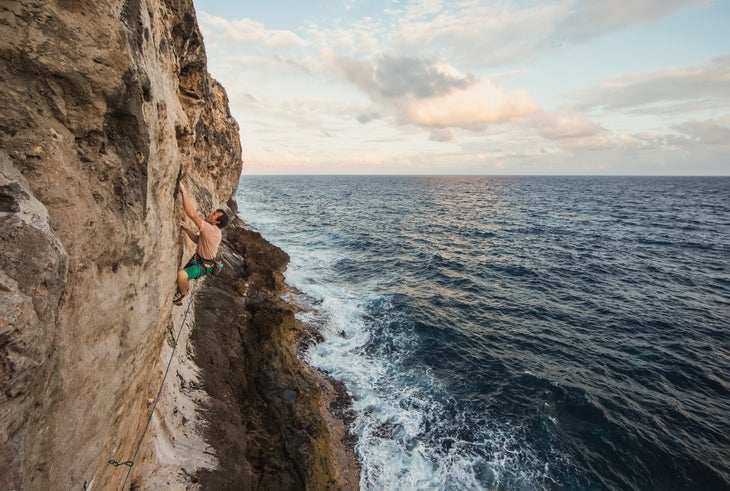
Our crew had come to wee (12 miles long by 1 mile wide) Cayman Brac in 2018, leaving Colorado on a blustery December morning. It was me, Senior Associate Editor James Lucas, the pro climber Nina Williams, Climbing’s Digital Editor Kevin Corrigan, Senior Contributing Photographer Andrew Burr, and Burr’s life and business partner, Juanita Ah Quin. We’d all come to the Point on a stormy afternoon to shoot Angel Robledo, a Brazilian transplant who has co-run the Cayman Islands’ Rock Iguana guiding service since 2017. Angel and her friend Armin Gooden wanted to climb Throwin’ the Tortuga, a classic 5.11b up an orange dihedral to a crux roof high over the waves.

The Point is one of the Brac’s 17 unique crags, which comprise 100-plus single-pitch sport routes up to 5.13 on limestone ranging from black, vertical, and spiny to wildly overhanging tufa, pocket, and colonette climbing. The 18 5.9 to 5.12c climbs at the Point are approached via hair-raising rappel to precarious stances above wave-battered hollows. The cliff sits at the isle’s northeast tip, amidst rock, sea, and jungle. Were you to fall into the drink, you’d need to swim for miles along the unbroken cliff line to find egress. And then, the “beach” would be ironstone and the waves would pummel you skinless. The commitment is palpable, especially when wind-driven swells boom against the rock.
In autumn 1996 on a similar high-wind day, Jeff Elison and Lizz Grenard, part of the early, northern Colorado crew who began bolting on the Brac, rapped in to make the first ascent of Wholy Huecos Batwoman (5.10c). Below the route, a hook-shaped rock creates a “whirlpool” that sends waves shooting straight up the wall. At the belay, wrote Elison in a trip report, “a large wave came right up to head level and soaked us both.” Elison led off post-haste. As he climbed above the fourth bolt, some 40 feet up, a second wave broke, he wrote, “within two feet of my heels.” So, what of his poor belayer? Grenard, immersed, had been lifted off her feet, flipped over, then slammed back onto the belay upside-down, hitting her head.
“When the water cleared she looked up at me with terror dripping from her face and requested that I get her the hell out of there,” wrote Elison. He climbed quickly to the fifth bolt, equalized it with a horn, and brought her up to this improvised anchor. From there, the two “shivered and cowered their way to the top.”
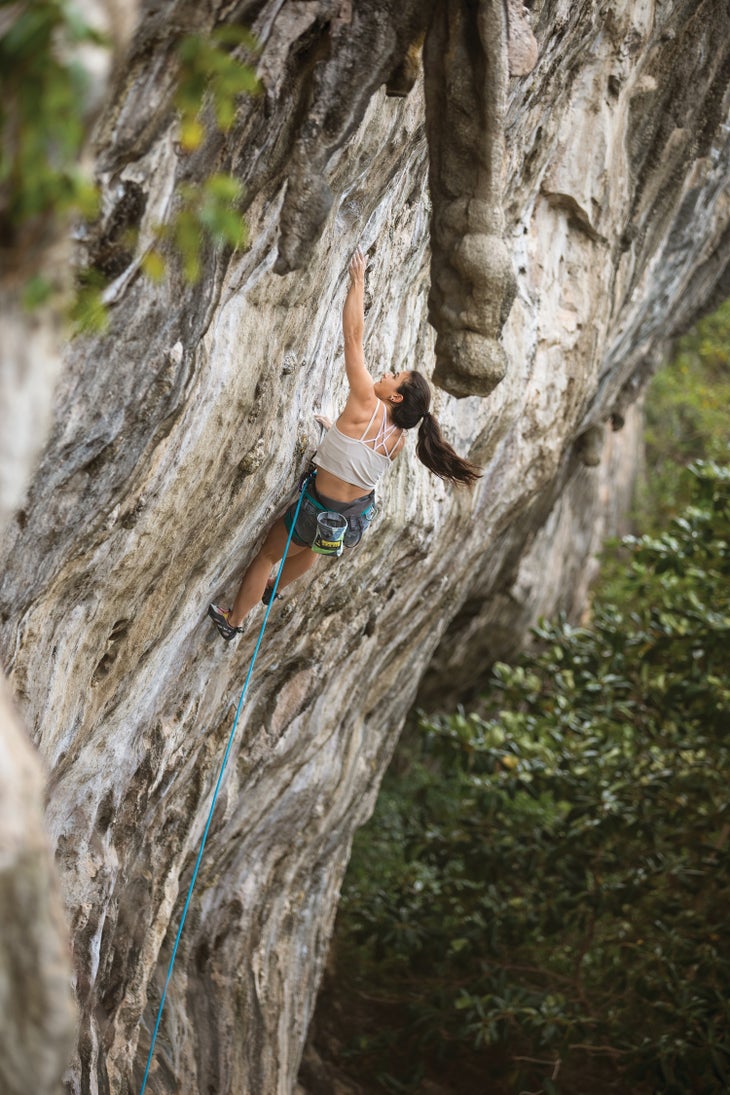
As I helped with rigging for the photo shoot, I wondered about the wisdom of dropping in on this unsettled day. Still, Burr, with his lifetime in the mountains, fierce blue eyes, and bushy Forty-Niner beard, loves “sketchy shit,” and Angel and Armin seemed game. While they climbed and shot, I walked along the 2.5-mile Lighthouse Footpath, which hugs the cliff edge west toward the more habitable lowlands of Spot Bay, home to much of the island’s best climbing. The trail began in the early 1900s as a way for locals to access the bluff to collect booby eggs and look out for ships. Beginning in the late 1920s, it became an access route for lighthouse keepers, who dragged handcarts full of gas cylinders out to power the lighthouse. As I wended through small, grassy valleys and clusters of silver thatch palms, and past massive agave plants, birds cried and flapped at the plateau’s edge. There, brown boobies roosted in the rocks, and I passed by quickly, going around these reclusive mini-pterodactyls with their inscrutable dinosaur eyes and long, pointy bills that resemble plague masks.
An hour later, back at the Point, the crew prepared to drop down Throwin’ the Tortuga. In an odd micro-phenomenon, the cliff itself, they said, was calm—it was just where the warm air met the lip that the wind was howling. This close to the equator, night falls fast, and though it was already 4:30—one hour shy of sunset—Armin, Angel, and Burr disappeared over the edge. After some fussing with the descent ropes and situating the belay, Armin led out in the gloom.
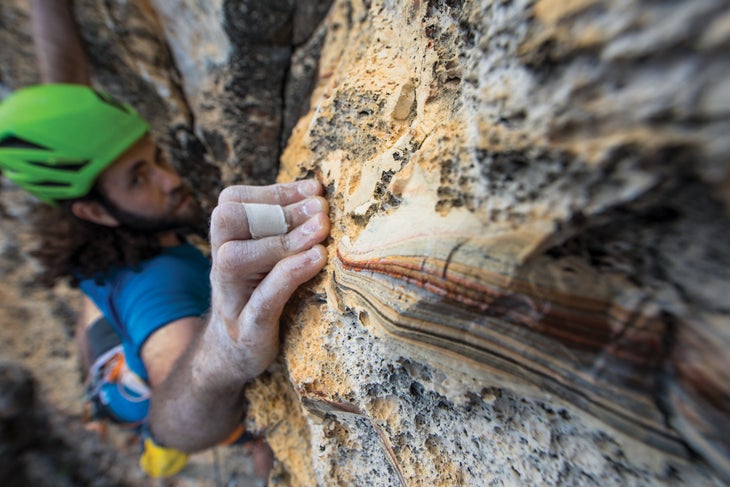
I crab-crawled to the edge. “Can you see them?” I asked Burr, who hung 30 feet below. “Like, are these photos going to come out?”
“Yeah, he’s heading up,” Burr said laconically. “I’m just keeping the shutter open to work with the light.”
A half hour later, Armin topped out, clipping the belay in the gloaming. He sported a massive grin, having onsighted a dream route.
“Good job,” I shouted, reaching down to pass him my headlamp as the wind tore the words from my mouth. “You might want this.”
As Armin belayed, the rope crept through his device. When Angel emerged onto the headwall, he shone the light for her—she hadn’t had a headlamp. I was glad when we were all on top. If you get into trouble on the Brac, there is no mountain rescue, nobody with the equipment or skills to reach you. There’s just you, the rocks, and the ocean.

“Oh, my god,” said Angel, coiling the rope. “I got hit by a wave, my shoes got wet, my chalkbag was soaked, and I’m freezing. And I had to climb mostly in the dark! I’m never going down there without a headlamp again. I should have known .… ”
But then: “That was the best route of my life!” gushed Armin, oblivious to Angel’s frustration, still awash in his post-send buzz.
“That was the worst climb I’ve ever had,” continued Angel, a former mountaineer. “Not even in the mountains have I been so miserable.”
* * *
Cayman Brac is the easternmost of the Cayman Islands, a string of three isles (Grand Cayman, Little Cayman, Cayman Brac) 200 miles south of Cuba. Unlike Grand Cayman, with its resorts, cruise ships parked in the harbor, and constant hum of tourist activity, the Brac is a relative backwater. There are only two thousand full-time “Brackers” and very few sandy beaches, with scuba diving being the main tourist lure, especially at the renowned MV Captain Keith Tibbetts, a 330-foot-long Russian frigate deliberately sunk to create an artificial reef. The Cayman Islands are autonomous British overseas territories, but given their proximity to the States have been sufficiently Americanized; other than driving on the left side of the road, you might as well be in Florida. Many inhabitants are of mixed English and African descent, a result of England’s importation of enslaved Africans beginning in the 1700s as the UK colonized the region.

Brac is Gaelic for “bluff” and refers to the limestone escarpment that forms the island’s backbone, gradually rising from cute, bouldering-height swells and blocs near the western end to its apex at the Point. All three Cayman islands are summits on the Cayman Ridge, which rises above the 25,000-foot deep (shudder) Cayman Trough—when you climb here, you’re essentially on the summit of a giant undersea mountain. Unique to the east end of Grand Cayman and to Cayman Brac is the mineral caymanite, which, with its bands of pastel tans, grays, oranges, and reds reminiscent of Jupiter’s clouds, can be found embedded on the climbs—and is used to make local jewelry.
Christopher Columbus discovered the then-uninhabited Cayman Brac and Little Cayman in 1503, naming the twin islands “Las Tortugas” for the sea turtles; later that century, the isles took the name the “Caymanes” from the Carib caimán—or marine crocodile—though the name may also have been spurred by iguana sightings. Cayman Brac was not permanently settled until 1830, and, with its seaside caves and rough terrain, was a sometime hideaway for pirates including Captain Morgan and Blackbeard, with accompanying lore about hidden gold. On the day we climbed at Neptune’s Lair, a seaside scarp on the north side of the island with a rock that looks, in profile, like the Roman sea god, two treasure hunters scrambled by, telling us they believed they’d find gold in a cave “because of the face.” The men later returned empty-handed, their metal detector zipped back into its bag.
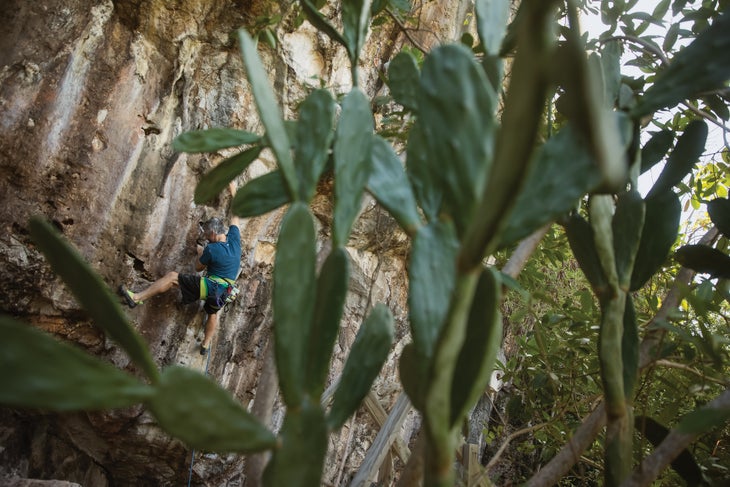
Climbing began on the Brac in 1994 thanks to the northern Colorado climber Skip Harper, who, as he wrote in “Hidden Treasure” (Rock & Ice No. 69), had been visiting the islands for years to dive. As Harper was celebrating a night dive off Grand Cayman with a local, he “remarked that I wanted to boulder on the coral-rock façade at the airport.” The local mentioned the Brac—namely the Point—and Harper, intrigued, chartered a seaplane. “A view from the air reveals an endless patchwork of dark-blue and fluorescent aquamarine, an endless aquarium of sharks, dolphins, turtles, and other sea life,” wrote Harper. “It also reveals beautiful multicolored cliffs rising from the sea.” That same year, Harper returned with Ernie Johnson to put up the island’s first climb, Chum Buckets (5.10b), at the Orange Cave on the south coast. The route was named for how the sharp upper stone—“edges covered with spicules reminiscent of hypodermic needles,” wrote Harper—savaged the climbers’ hands.
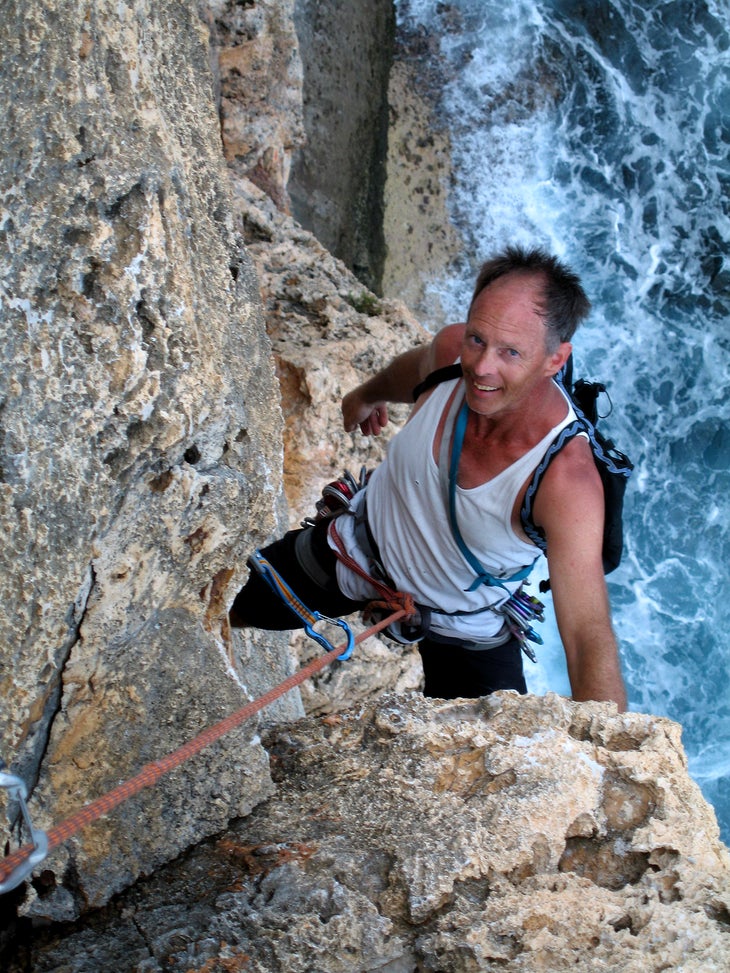
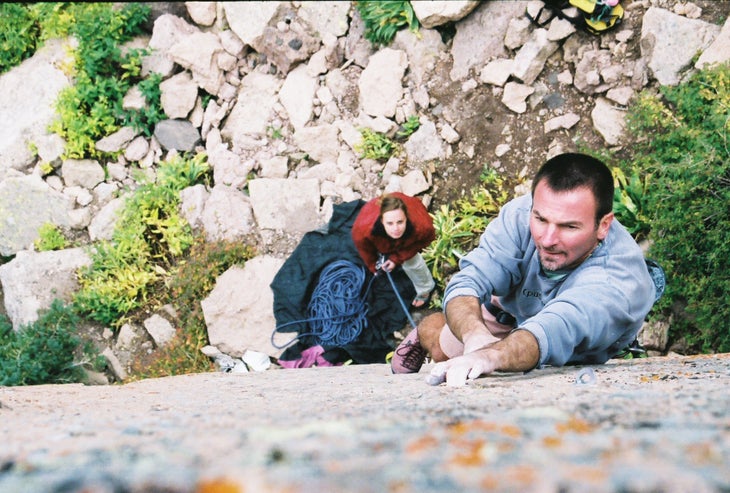
Back in the States, Harper rallied fellow Coloradans, including Elison, Grenard, and the late Craig Luebben. In March 1995, the climbers established a few more routes at the unassuming Orange Cave. Elison, who would go on to establish many of the island’s testpieces, including the bouldery Get It Together (5.12d/13a) on the Wave Wall, recalls his initial impression. “Skip had drilled two pretty crappy routes out by the Orange Cave—Shark Attack and Chum Buckets,” he says. “The guy’s just a sprayer—‘It’s the best climbing; it’s unbelievable.’” But when the climbers got out to this sunny cliff, they were, says Elison, underwhelmed by the “hot, slimy” venue; Elison even recalls thinking, “What a waste of money coming down here.” Visiting the Point, however, quickly changed his mind.
Here, the climbers opened Shiver Me Timbers (5.10b) and Throwin’ the Tortuga (5.11b), selecting these and later lines based on a chartered boat tour Harper had taken and also just throwing their ropes down to have a look at the walls. On that trip, they established 16 routes at the Point, and on that and two later visits (1996 and 1997), Elison and Grenard would bring their Brac FA total to 43 climbs. Today a professor of psychology at Adams State University in southern Colorado, Elison recalls these being some of the “best climbing days of my life” for the sense of freedom and exploration. In 1996, when he spent 32 days on the island, Elison was so psyched to bolt that he couldn’t bring down all the metal himself, and had friends help carry it in their luggage.
In January 1997, John Byrnes, another northern Colorado climber and a now-retired engineer, made his first visit. He’s since become the island’s unofficial climbing mayor, and runs the Bluff View house (climbcaymanbrac.com), a serene rental property on the south side. Tall, lanky, and sport-climber fit, Byrnes spends six weeks each year on the Brac. Without his new-routing, and his and others’ bolt-upgrading efforts, there would be no climbing here. In fact, the hardware would be rust.
Back in the mid-1990s, climbers bolted using whatever hodgepodge of bolts and hangers they could find, and concepts like galvanic corrosion and stress-corrosion cracking had yet to enter the climbing parlance. And so, the early climbers on the Brac used stainless steel. However, the bolts began to fail by 1999. A couple of visiting climbers decked due to hardware failure, and Byrnes snapped off an 18-month-old bolt while cleaning draws off Reef on This (5.10d) at the Wave Wall. In February 1999, Byrnes published an article in Rock & Ice telling climbers to stay away until a solution could be found—though he had no idea, in this pre-titanium era, what that solution was.

In May 1999, Mike Shelton, a climber and welding metallurgist, called Byrnes to chat, having just returned from Thailand, which was experiencing similar issues. Byrnes sent Shelton a broken Brac bolt, and Shelton confirmed it had failed due to stress-corrosion cracking—the steel corroding from the outside in via small, often invisible fissures. Shelton, Byrnes, and Harper reached out to Jim Bowes, another northern Colorado climber, who was a founder and general manager of the US-Russian outfit Ushba and had a few concept titanium bolts. As the men gathered at CooperSmith’s pub in Fort Collins, they refined their design and came up with a production schedule and a name—the “Tortuga.” Eighteen months later, in November 2000, they had a product in hand and began to upgrade routes at the Brac.
“From 2000 to 2002, we mainly just rebolted,” recalls Byrnes. (At this point, the island had nearly 80 climbs.) Installing glue-ins is time-consuming work, not to mention that titanium is expensive—for example, $13 today for a single Eterna bolt. The climbers had re-equipped 44 routes before Ushba tanked in 2002, leaving them without a supplier. Then, in 2011, thanks to the grassroots “The Thaitanium Project,” founded by the Boulder, Colorado, climber Josh Lyons, climbers who bolted in maritime environments were able to get titanium bolts again by making bulk orders (the minimum order was $20,000) from United Titanium in Ohio. Eventually wanting a more official solution, the UK climber Martin Roberts started Titan Climbing, which today produces the Eterna. As Byrnes continues to establish new routes on the Brac, he uses leftover Tortugas, with their thicker metal, for anchors, and Eternas for the lead clips. In 2011, Byrnes organized a major rebolting effort, and in 2013 he and former Climbing editor Jeff Achey began to establish new climbs. Byrnes has since put up three-dozen new routes on the Brac, including the seven clean, vertical routes on the high-quality Valentines Wall in 2017.
Photo Gallery: Scenes From Cayman Brac
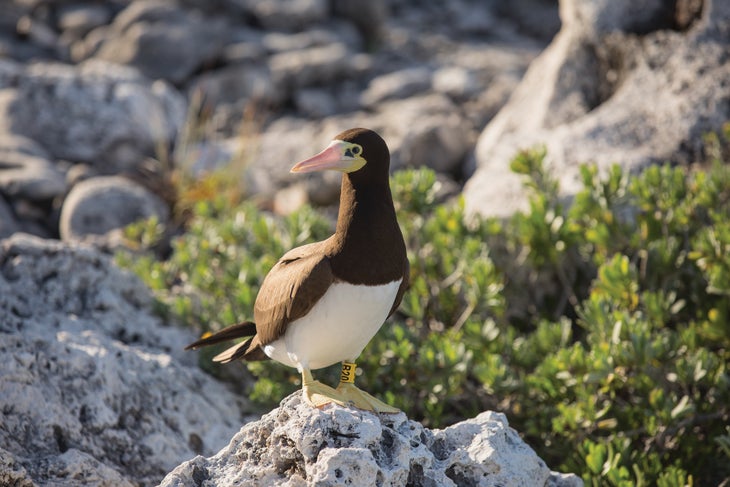
A brown booby on Long Beach.
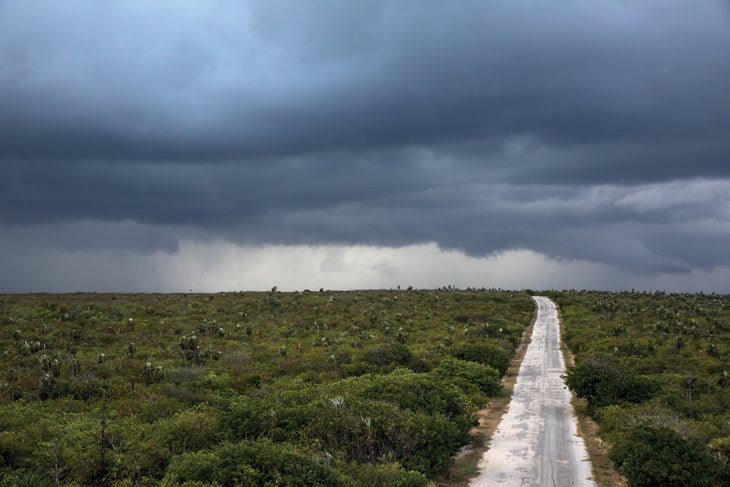
The lonely road to the Northeast Point, slick with rain after a passing squall.

Palm trees + sunset + tropical island = paradise at the Cayman Brac Beach Resort.
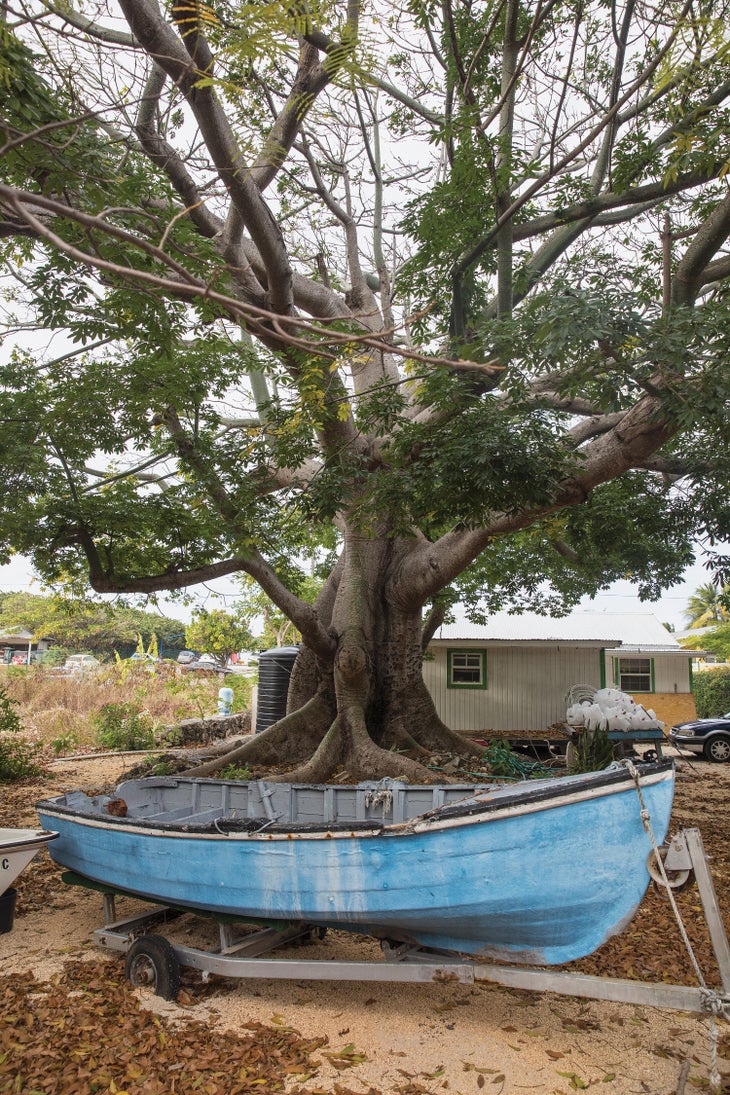
A fishing boat and epic tree in the Dixons’ backyard, which you must pass through (ask permission!) to access the climbing.
* * *
“How hard do you think that dyno was?” I asked Nina, who had just sauntered up the Byrnes open project In Vino Veritas (5.13a/b) on Dixon’s Wall, flashing its first ascent, smoothly linking its deep pockets, monster leap to a sidepull hueco, tufa cranks out a bulge, and finishing headwall on crimpy blue stone.
“I dunno. V4?” she said, then burst out laughing.
“Feck,” I said. James and I had each put in a burn and failed to do the dyno, though I’d at least figured out the setup beta—left-hand undercling pocket, right-hand jizzly sloper, feet on barnacles, leap!
“Nina’s kind of a sandbagger,” James said. “Watch out for her.”
The trip went pretty much like that. One of us would go first, chalking, hanging the draws, working out the sequences, brushing off accumulated sea salt and other smeg. Then the others would try it—which usually seemed to involve Nina flashing whatever climb the rest of us had been toiling on, except for one route, the open project Anansi (5.13a/b) at Heritage Wall, that I managed to scoop her on. This day, our second at Dixon’s, conditions were “tropical dreamy,” meaning a trade wind was blowing, it was only in the 70s, and humidity was sub-50-percent, unlike our first day, which had been in the high 80s with no wind and palpably moist air. And which had seen us spend half our time on our backs, jet-lagged, lethargic, sweating, heat-stunned, looking numbly up at the web of bulges, tufas, flowstone, and stalactites overhead while roosters crowed in the background.

From a purely visual standpoint, tropical limestone is dreamy, with blue-gray swells rising above palm trees and sandy beaches. But on a tactile level, it’s punishing, with your feet swelling in the heat and salt air, your skin growing mushy, every hold feeling like it’s been coated in butter, and the term “good conditions” involving some serious recalibration. On an island like the Brac, where the average temperature during the coldest month, January, is 77°F, the one certainty is that you never climb in the sun. (Though in January 1996, Elison recalls a freak cold snap that let the climbers put up routes in the direct sun, at the Love Shack on the south side of the island.) Fortunately, Dixon’s Wall, on the north side, is in the shade all day in winter.
Dixon’s, the island’s best wall, would be a top-shelf venue anywhere, with its impeccable rock and 19 climbs from 5.10 to 5.13 on a tufa-laced, 90-foot-high panel that crests overhead. It takes its name from the Dixon family and their patriarch, Hindenburg Dixon, whose land you must cross—the cliff is literally in the Dixons’ backyard. Fortunately, like all of the Brackers we met, the incredibly friendly Dixons are psyched to see climbers. Simply walk up to the house, knock, ask to climb, and off you go. Cayman Brac’s cliffs are considered “crown land”—themselves and land 10 feet to either side are owned by the government and hence open to the public.
Climbing started at Dixon’s in 1996 with Elison and crew. “We had been driving past these [north walls] and sneaking through the locals’ yards for several weeks without taking that big first step,” wrote Elison in a trip report. Then, with a local’s permission, they began working the first route here, Elison going ground-up on Lizzard the Gizzard (5.11d/12a), using hooks and threads between bolt placements. While the lower stretch of the route is vertical, the headwall tilts out into a steep stalactite maze. Climbing onsight, Elison reached a stance. “Bail or go for it?” he wondered. By proving to himself that he could let go with either hand and shake out for 45 seconds, Elison built the confidence to pull up the drill. “Several minutes later the bolt was in, I was hanging, and my stomach was about to heave,” he wrote.
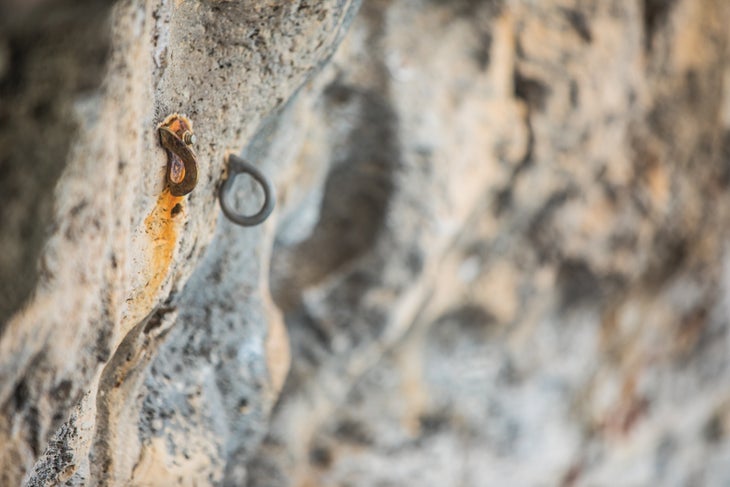
The next day the climbers returned and finished the route, then began work on a similar four-star line just to its right. As they drilled, the Dixons came up with fresh water and cups, then moved the wire fence behind their property and used a machete to cut an access trail. At 5 p.m., as the climbers knocked off for the day, the Dixons invited them for rum punch. “Three generations of Dixons watched, cheered, questioned, and welcomed us,” wrote Elison. In honor of their hosts’ hospitality, they named the second route Dixon’s Delight; at a physical, complex 5.11b, it is one of the best 5.11 sport pitches I’ve done.
Like many walls on the Brac, Dixon’s has a preponderance of 5.11s and 5.12s, with other standouts being Out of Africa (5.11d), Boom! (5.12a), and Carpe Stalactite (5.12b). Lying on the continuously overhanging right side are In Vino Veritas and its companion Pole Dancer (5.13a), a six-bolt power-endurance sprint up a vaguely extruded tufa. Small pockets and incipient colonettes color the gray limestone in between the routes, and we wondered whether these unbolted lines would go. The Brac has potential for more difficult climbs, including an open project at Neptune’s Lair and untapped terrain at the Wave Wall and at Dixon’s. The question, however, becomes how hard can you climb in the heat? As we surveyed the virgin grips, I wondered if even Adam Ondra would hit his limit at 5.13d, or what sort of meteorological fluke—a freak cold front or maybe the winds out ahead of a hurricane—you’d need to climb 5.14.
* * *
Our days on the Brac took on a certain rhythm, a simplicity and laidback pace. Thanks to the Cayman Islands Department of Tourism, we were staying at the Cayman Brac Beach Resort, a valet diving resort (like, they take you out on a boat from the resort) with a pool, hot tub, sandy beach and hammocks, and—most perilously—a delicious buffet that sent everyone but me home with “buffet belly,” as I wisely swapped salad for dessert.
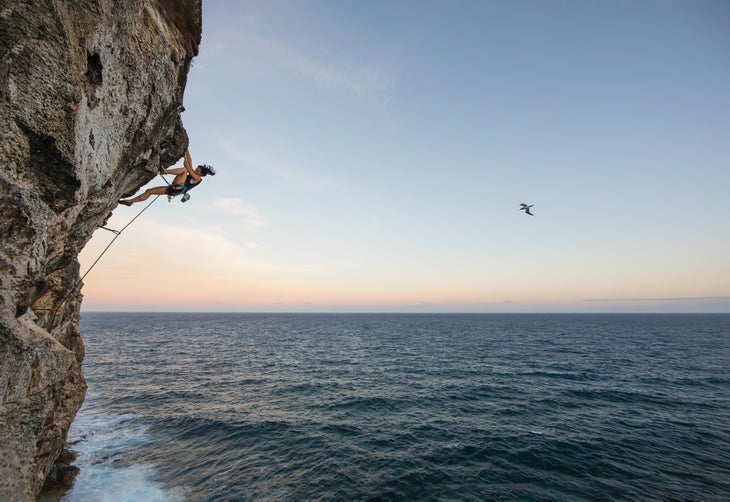
Each morning, we’d pile into our rental cars and drive east, almost invariably finding the crags empty, synching up with Angel when she wasn’t guiding or doing construction work on her open-air yoga studio below the Yogi Wall, a new sector on her property on the island’s south side. The Brac has two main east-west roads, the north road being the most developed, with all the stores, schools, hospital, etc. The south road is beach, jungle, and big aqua sky—and, like, 10 million wandering chickens, a non-native species that far outnumbers Brackers and is said to have eaten up most of the iguanas. James wanted a photo of a chicken crossing the road for Instagram, but every time we stopped the car and he ran toward the birds they’d evaporate back into the jungle.
“Goddamn chickens,” James would grumble. “I’ll never know why they’re crossing the road.”
Rest days were divine, spent riding bikes, exploring caves, snorkeling, and playing in the waves at the picture-perfect, always-empty “Public Beach.” This is the Brac’s allure: It really is an unpopulated paradise, and if you want rocks and sea but hate logistical hassles (ugh) and humans (barf), then there’s no better venue. Maybe it’s the paucity of sandy beaches or the hostility of the terrain—sinkhole-riddle ironstone overlaid with jungle so thick Byrnes was nearly benighted in a hungry, exhausted, and dehydrated state, lost in the tangle atop Dixon’s Wall while going around to drill anchors. Or maybe it’s the island’s size, which can provoke a frisson of angst as you realize “I’m just one small person on this tiny hunk of rock” Or maybe it’s just how far the Brac is from everything—the sense of isolation. But to my mind, all these things make Cayman Brac a wonderful destination.
As our trip wound down, we made a final foray to the Wave Wall, a Buoux-like swell of pocketed limestone hard over the sea, reached via a scramble that’s suicide at high tide or with big seas. This day, the rowdy waves slapped up in sets over the white-dark border of the highwater line. We wanted to try Pirates of Pissants, a six-bolt 5.12d Elison route up a smooth white face. I went first, brushing holds, hanging draws, blowing out crystals of sea salt, chalking the best grips as the waves crashed what felt like inches behind my head. When I had a workable sequence that involved a mega-drop-knee and drive-by move to a recessed pocket, I lowered off, back to our little pedestal. We could see a boat on the horizon, but otherwise there was no sign of humanity, the only sounds the waves and the clicking of Burr’s camera.

James went next, then it was Nina’s turn. Fresh off taking a pro-climber selfie, she shoed up, took a breath, pulled on—and flashed.
“Nice, Nina!” James and I hooted as she clipped the anchors. I lowered her, James threw her rope to pull herself back into the belay, and then it was my turn again. It was 4:30 now—only an hour till dark, the equatorial sky bruising deep indigo. I’d have to climb quickly. We still needed to collect our gear and get back across the slabs. It was time to get going. On Cayman Brac, the night waits for no one.
Cayman Brac Logistics
Getting there
Fly into Grand Cayman (direct flights available from Denver via Cayman Airways—caymanairways.com) then take a Cayman Airways flight to the Brac ($160 round-trip).
Getting around
You’ll want a rental car, as the crags are all grouped on the island’s unpopulated eastern tip. We got ours through CB Rent-A-Car (cbrentacar.com).
Lodging
Climbers typically stay at John Byrnes’s Bluff View house, with many crags in walking distance. There is also the amazing, all-inclusive Cayman Brac Beach Resort, with its pool, sandy beach, buffet, and seaside hammocks.
Season
Late November through April; early spring has the advantage of fewer hours of sun on the south side, making it possible to spend more time at the Love Shack, Wave Wall, Orange Cave, etc.
Route beta
Find an up-to-date guide and island beta at climbcaymanbrac.com. If you decide to establish new climbs, you must use titanium glue-in bolts or your hardware will rot; do not trust any existing bolts that aren’t titanium!
Guide service
Rock Iguana offers guided climbing all over the island, including rappelling/caving/multi-pitch tours on the Point and yoga + climbing at the Yogi Wall.
Must-haves
- Sturdy approach shoes
- Sunblock
- Sunhat
- Belay gloves/leather gloves
- Snorkeling gear (or rent it at the Beach Resort)
- For rapping in/escape at the Point: static line/extra rope, rope protectors, and Tiblocs or other lightweight ascenders
Top 10 Recommended Routes
The bulk of the Brac’s climbs are in the 5.10-to-5.12 range. On lower-angled, more moderate terrain, the rock is often so sharp as to preclude development.
Old School (5.8), Wave Wall
Bucket-hauling up classic Brac huecos on choice white rock (the 5.10s around it are
killer, too).
What’s the Point? (5.9), Northeast Point
Sharp rock and spicy runouts, but an amazing position on the prow.
Dixon’s Delight (5.11b), Dixon’s Wall
It’s hard to believe this king line goes at 5.11, but it does—unless you stray left at the crux (all the 5.12s around it are four stars as well).
Throwin’ the Tortuga (5.11b), Northeast Point
Long, physical, and perplexing on dreamy white stone.
Flying the Colors (5.11c/d), Sector Seahorse
Fun, roamy climbing leads to an exposed nose with big cranks to miracle buckets.
The Poseidon Adventure (5.12a), Neptune’s Lair
A commanding position hard over the waves on incut huecos.
Carpe Stalactite (5.12b), Dixon’s Wall
Steep, punchy, and go-ey. You will never forget the step-across move!
Freedom (5.12c), Northeast Point
A long pitch with three distinct cruxes and loads of 5.11 in between. Full value!
Pirates of Pissants (5.12d), Wave Wall
Physical pocket-tugging on a smooth, intimidating panel tilted over the sea.
Pole Dancer (5.13a), Dixon’s Wall
A power-endurance masterpiece on incut, tufa-tastic holds.
Matt Samet is still scheming how he’ll get “back to the Brac” in the near future.